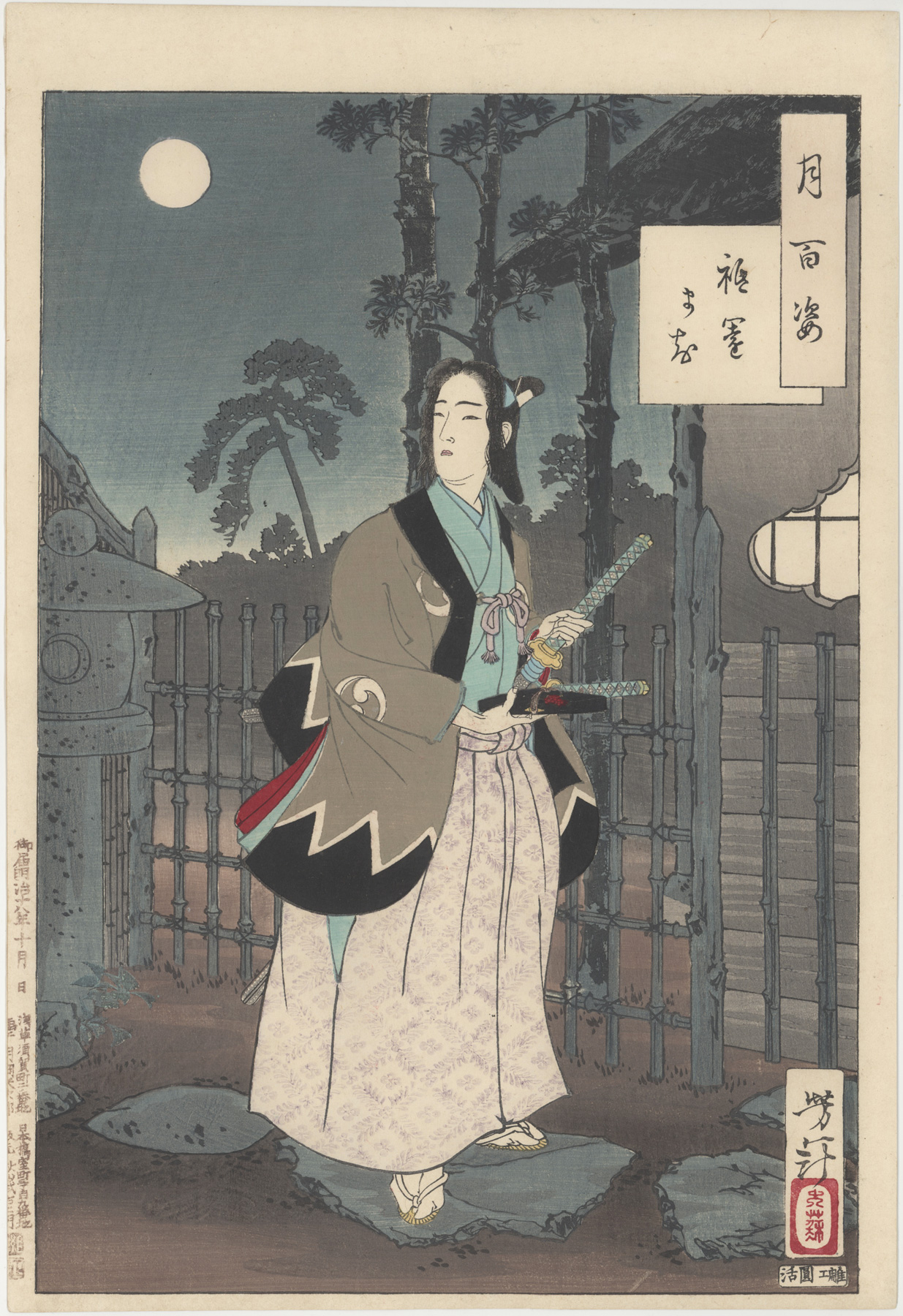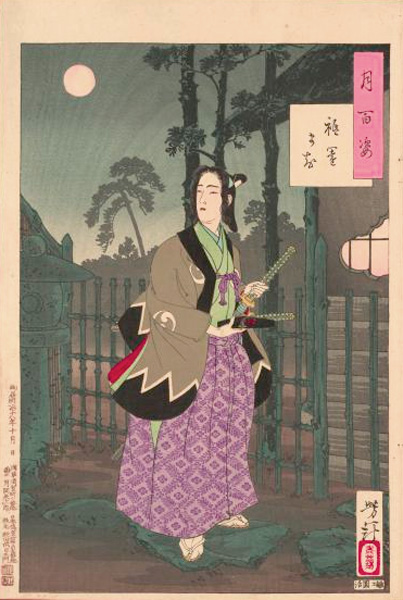About This Print
The Story Depicted in the Print as Told by John Stevenson
Source: Yoshitoshi's One Hundred Aspects of the Moon, John Stevenson, Hotei Publishing, Netherlands 2001.4. The Gion district
Gionmachi
Shown here is a scene from one of the most popular of allKabuki plays, Kanadehon Chūshingura, literally“The Syllabary List of the Treasury of Loyal Retainers,” more commonly known inthe West as “The Forty-seven Ronin.” Rōnin means “wave man” and indicates amasterless samurai.
This sensational tale of revenge is based on actual eventsthat took place between 1701 and 1703. Lord Asano, an inexperienced country nobleman at the palace of theshogun in Edo, was required to receive an imperial envoy from Kyoto. Lord Kira, an expert in court ceremony, wasassigned to assist him, but Asano failed to give him the accustomed bribe. Kira taunted Asano for his lack ofsophistication until Asano lost his temper, drew his sword, and woundedKira. For the crime of drawing a weaponin the palace, the shogun ordered Asano to commit suicide. Two years later, Asano’s retainers avengedtheir master by killing Kira and laying his head at Asano’s tomb. They were then all obliged to commit suicidethemselves.
These events captured the public imagination and withinthree years the first of many dramatizations of the events had been written andperformed. To comply with governmentregulations prohibiting the portrayal of contemporary or sensitive events, theplay was set in the fourteenth century at the palace of Shogun Takauji inKyoto. The names of the principalcharacters were changed: Asano became En’ya Hangan, Kira became Kō no Moronao –both historical characters – while the leader of the band of masterless samuraiwas called Oishi Yuranosuke.
The design is taken from Act VII of the play. The scene is set outside the Ichikiriteahouse in the Gion district, an entertainment area on the east bank of theKamo river in Kyoto. The Ichikiri isstill operating, and as a result of the story of the Forty-seven Ronin isprobably the best-known teahouse in Japan today.
Yuranosuke has made his headquarters in the teahouse, wherehe is pretending to live a dissolute life in order to lull Moronao into a falsesense of security. Yuranosuke’s son,called Rikiya in the play, is delivering a letter from En’ya’s wife, LadyKaoyo, to his father which contains news of the conspirators’ activities. He cannot deliver the letter openly – helooks around him while knocking his sword guard against its sheath to gain hisfather’s attention.
The young man stands on a flagstone path, near a stonelantern in the garden of the elegant teahouse. Only seventeen, he still wears a boy’s long forelocks, as he does in theplay. His short coat has an abbreviatedversion of the jagged black-and-white design that became the symbol of theForty-seven Ronin. His seriousexpression and obvious youth make his fate, as the youngest conspirator to diefor his loyalty, doubly poignant. Thewide brushstrokes representing the trees and the roof of the teahouse have beenexpertly reproduced by the engraver, including areas of “flying white” left bythe artist’s fast-moving brush. The grainof the woodblock adds texture to the night sky.
This is not a particularly significant moment in the play,nor does the moon play any role at this point in the story, although it iscrucial for the final episode. Yoshitoshi’s audience would have known the play thoroughly, however, andwould have enjoyed recognizing the minor scene.
Image from Publisher's Bound Album (Issued shortly after Yoshitoshi's death)
About the Series "One Hundred Aspects of the Moon"For details about this series which consists of one hundred prints with the moon as a unifying motif, see the article on this site Yoshitoshi, One Hundred Aspects of the Moon.
Print Details
| IHL Catalog | #1375 |
| Title | Gion District (Gion machi 祇園まち) |
| Series | One Hundred Aspects of the Moon (Tsuki hyaku sugata 月百姿) |
| John Stevens Reference No.* | 4 |
| Artist | Tsukioka Yoshitoshi (1839-1892) |
| Signature | Yoshitoshi 芳年 |
| Seal | Taiso 大蘇 |
| Date | October 1885 (御届明治十八年十月 日) |
| Edition | Likely from a bound album. |
| Publisher | Akiyama Buemon (秋山武右エ門) [Marks: seal 26-132; pub. ref. 005] |
| Carver |  |
| Impression | excellent |
| Colors | excellent |
| Condition | excellent - original backing |
| Genre | ukiyo-e |
| Miscellaneous | |
| Format | oban |
| H x W Paper | 14 3/16 x 9 5/8 in. (36 x 24.4 cm) |
| H x W Image | 13 x 8 13/16 in. (33 x 22.4 cm) |
| Collections This Print | Smithsonian National Museum of Asian Art S2003.8.3020; Yale University Art Gallery 2011.143.1.4; The British Museum 1906,1220,0.1394; Tokyo Metropolitan Library 加4722-68 and 5333-60-68; Hagi Uragami Museum (Yamaguchi, Japan) UO1505; The Tsubouchi Memorial Theatre Museum of Waseda University 401-0491; Ritsumeikan University Art Research Center AcNo. arcUP2023; Art Gallery of Greater Victoria 258.2012.4 |
| Reference Literature | * Yoshitoshi’s One Hundred Aspects of the Moon, John Stevenson, Hotei Publishing, Netherlands 2001, pl. 4. |



